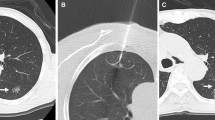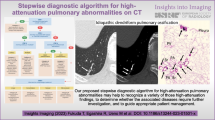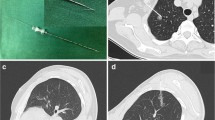Abstract
Purpose
To determine cellular viability of lung parenchyma and neoplastic cells in areas of ground-glass opacity (GGO) on computed tomography (CT) images immediately after pulmonary radiofrequency ablation (RFA) in rabbits.
Materials and methods
A LeVeen RFA electrode was placed percutaneously into rabbit lungs with or without metastatic VX2 tumors. Five minutes later, seven isolated lungs were imaged by use of a multi-detector row CT scanner, and the images were compared with histological features. The cellular viability of the lung tissues was assessed by nicotinamide adenine dinucleotide hydrogen (NADH) staining in eight normal lungs and in three lungs with multiple metastatic tumors.
Results
All lung lesions appeared as bilayered structures with a central, dense, attenuated area and an outer area of GGO on CT images, and as three-layered structures on macroscopic and microscopic images 5 min after RFA. The GGO areas approximately corresponded to the outer two layers in macroscopic images that were exudative and congestive on microscopic images. Staining for NADH was significantly reduced in the GGO and densely attenuated areas with or without tumor tissue staining compared with the non-ablated area.
Conclusions
Our results suggest that an area of GGO that appears on CT immediately after RFA can be effectively treated by RFA.






Similar content being viewed by others
References
Fry WA, Phillips JL, Menck HR. Ten-year survey of lung cancer treatment and survival in hospitals in the United States: a national cancer data base report. Cancer. 1999;86:1867–76.
Simon CJ, Dupuy DE, DiPetrillo TA, Safran HP, Grieco CA, Ng T, et al. Pulmonary radiofrequency ablation: long-term safety and efficacy in 153 patients. Radiology. 2007;243:268–75.
Gazelle GS, Goldberg SN, Solbiati L, Livraghi T. Tumor ablation with radio-frequency energy. Radiology. 2000;217:633–46.
Kelekis AD, Thanos L, Mylona S, Ptohis N, Malaqari K, Nikita A, et al. Percutaneous radiofrequency ablation of lung tumors with expandable needle electrodes: current status. Eur Radiol. 2006;16:2471–82.
Wolf FJ, Grand DJ, Machan JT, Dipetrillo TA, Mayo-Smith WW, Dupuy DE. Microwave ablation of lung malignancies: effectiveness, CT findings, and safety in 50 patients. Radiology. 2008;247:871–9.
Bojarski JD, Dupuy DE, Mayo-Smith WW. CT imaging findings of pulmonary neoplasms after treatment with radiofrequency ablation: results in 32 tumors. AJR. 2005;185:466–71.
Yamamoto A, Nakamura K, Matsuoka T, Toyoshima M, Okuma T, Oyama Y, et al. Radiofrequency ablation in a porcine lung model: correlation between CT and histopathologic findings. AJR. 2005;185:1299–306.
Hiraki T, Tajiri N, Mimura H, Yasui K, Gobara H, Mukai T, et al. Pneumothorax, pleural effusion, and chest tube placement after radiofrequency ablation of lung tumors: incidence and risk factors. Radiology. 2006;241:275–83.
Neumann RA, Knobler RM, Pieczkowski F, Gebhart W. Enzyme histochemical analysis of cell viability after argon laser-induced coagulation necrosis of the skin. J Am Acad Dermatol. 1991;25:991–8.
Okuma T, Matsuoka T, Okamura T, Wada Y, Yamamoto A, Oyama Y, et al. 18F-FDG small-animal PET for monitoring the therapeutic effect of CT-guided radiofrequency ablation on implanted VX2 tumors in rabbits. J Nucl Med. 2006;47:1351–8.
Hyoudou K, Nishikawa M, Umeyama Y, Kobayashi Y, Yamashita F, Hashida M. Inhibition of metastatic tumor growth in mouse lung by repeated administration of polyethylene glycol-conjugated catalase: quantitative analysis with firefly luciferase-expressing melanoma cells. Clin Cancer Res. 2004;10:7685–91.
Yasui K, Kanazawa S, Sano Y, Fujiwara T, Kagawa S, Mimura H, et al. Thoracic tumors treated with CT-guided radiofrequency ablation: initial experience. Radiology. 2004;231:850–7.
Goldberg SN, Gazelle GS, Compton CC, McLoud TC. Radiofrequency tissue ablation in the rabbit lung: efficacy and complications. Acad Radiol. 1995;2:776–84.
Miao Y, Ni Y, Bosmans H, Yu J, Vaninbroukx J, Dymarkowski S, et al. Radiofrequency ablation for eradication of pulmonary tumor in rabbits. J Surg Res. 2001;99:265–71.
Lee JM, Jin GY, Li CA, Chung GH, Lee SY, Han YM, et al. Percutaneous radiofrequency thermal ablation of lung VX2 tumors in a rabbit model using a cooled tip-electrode: feasibility, safety, and effectiveness. Invest Radiol. 2003;38:129–39.
Anderson EM, Lees WR, Gillams AR. Early indicators of treatment success after percutaneous radiofrequency of pulmonary tumors. Cardiovasc Intervent Radiol. 2009;32:478–83.
de Baère T, Palussière J, Aupérin A, Hakime A, Abdel-Rehim M, Kind M, et al. Midterm local efficacy and survival after radiofrequency ablation of lung tumors with minimum follow-up of 1 year: prospective evaluation. Radiology. 2006;240:587–96.
Michaels MJ, Rhee HK, Mourtzinos AP, Summerhayes IC, Silverman ML, Libertino JA. Incomplete renal tumor destruction using radio frequency interstitial ablation. J Urol. 2002;168:2406–10.
Anderson JK, Baker M, Jaffers O, Pearle MS, Lindberg GL, Cadeddu JA. Time course of nicotinamide adenine dinucleotide diaphorase staining after renal radiofrequency ablation influence viability assessment. J Endourol. 2007;21:223–7.
Stern JM, Anderson JK, Lotan Y, Park S, Cadeddu JA. Nicotinamide adenine dinucleotide staining immediately following radio frequency ablation of renal tumors—is a positive stain synonymous with ablative failure? J Urol. 2006;176:1969–72.
Goldberg SN, Hahn PF, Tanabe KK, Mueller PR, Schima W, Athanasoulis CA, et al. Percutaneous radiofrequency tissue ablation: does perfusion-mediated tissue cooling limit coagulation necrosis? J Vasc Interv Radiol. 1998;9:101–11.
Yan TD, King J, Sjarif A, Glenn D, Steinke K, Morris DL. Percutaneous radiofrequency ablation of pulmonary metastases from colorectal carcinoma: prognostic determinants for survival. Ann Surg Oncol. 2006;13:1529–37.
Lencioni R, Crocetti L, Cioni R, Suh R, Glenn D, Regge D, et al. Response to radiofrequency ablation of pulmonary tumours: a prospective, intention-to-treat, multicentre clinical trial (the RAPTURE study). Lancet Oncol. 2008;9:621–8.
Beland MD, Wasser EJ, Mayo-Smith WW, Dupuy DE. Primary non-small cell lung cancer: review of frequency, location, and time of recurrence after radiofrequency ablation. Radiology. 2010;254:301–7.
Dupuy DE. Image-guided thermal ablation of lung malignancies. Radiology. 2011;260:633–55.
Acknowledgments
We are deeply grateful to Ms Kyoko Ohashi for technical assistance.
Author information
Authors and Affiliations
Corresponding author
About this article
Cite this article
Kuroki, M., Nakada, H., Yamashita, A. et al. Loss of cellular viability in areas of ground-glass opacity on computed tomography images immediately after pulmonary radiofrequency ablation in rabbits. Jpn J Radiol 30, 323–330 (2012). https://doi.org/10.1007/s11604-012-0054-y
Received:
Accepted:
Published:
Issue Date:
DOI: https://doi.org/10.1007/s11604-012-0054-y




